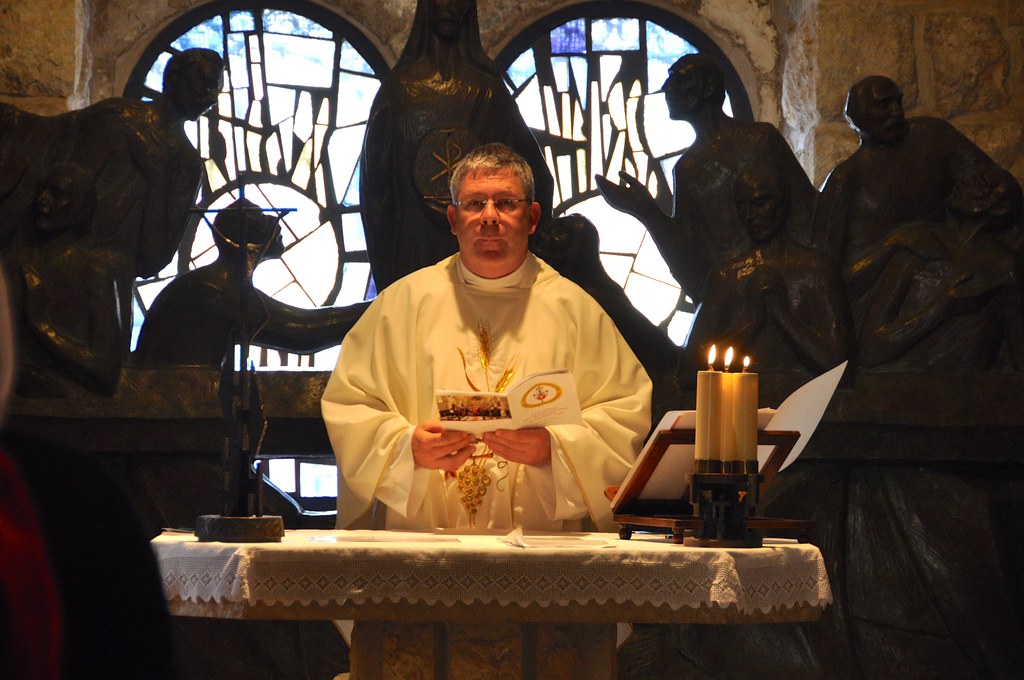We began our final day in Jerusalem on foot and walked through the Armenian quarter of the city to visit Mount Zion. Our first stop was the Church of the Dormition, the traditional site of the Assumption of the Blessed Virgin Mary into Heaven. The group fell into a prayerful silence after reciting the rosary and lighting candles around the spot, underneath the main church, where the Assumption is said to have taken place.
The Cenacle, or Upper Room, was our next stop as we began to trace the steps of Jesus on the night before his Crucifixion. This is the traditional site of the Last Supper where Jesus celebrated the Passover meal with his disciples before going to pray in the Garden of Gethsemane where he was betrayed by Judas. However, several sites claim to be the location of the Last Supper, so the actual site remains unknown.
Not far from the Cenacle is the Franciscan Church of the Last Supper where Fr Paul McDermott, the pilgrimage director, celebrated the Mass for Maundy Thursday. Members of the group said that it was particularly moving to have Mass in the place where the Sacrament of the Eucharist was first celebrated.

Fr John Farrell preached the homily, in which he reflected on Christ’s institution of the Sacrament of the Eucharist at the Last Supper: 'Why did he wait until now? To be betrayed by someone, we must love and trust them first to put ourselves in the possibility of this position. Betrayal is the risk of being human. Christ must enter into the depths of sin and sadness to fully redeem us.'
Fr John described Jesus as a ‘spiritual doctor’ for us. Both St Thomas Aquinas and Pope Francis stress that the Eucharist is medicinal. It is given to nourish and strengthen what has been damaged in us. During that night in Gethsemane, Jesus becomes present in all our own sorrow and sinfulness. Returning to the theme of the Eucharist, Fr John explained that in the sacrifice of the Mass we are all brought to God for healing. Through the mercy of God in the sacrifice of the Mass we reenter into this powerful mystery of Christ’s death and resurrection.
Continuing to follow the events of Jesus’ final night before his crucifixion, we visited the Church of St Peter in Gallicantu, ‘Gallicantu’ meaning ‘cock’s crow’. This is thought to be the site of the High Priest Caiaphas’ palace, and therefore the site where Peter denied Jesus three times in the palace courtyard. Below the church is the cell in which Jesus spent his final night having been questioned by the High Priest. Gathered in this small cell, which was originally only accessible through a hole in the roof, we recited psalm 88, the psalm which it is thought Jesus recited during that final night after his arrest.
Moving over to the other side of the Kidron Valley, we descended  the Mount of Olives beginning at the Church of the Pater Noster, the site where Jesus taught his disciples to pray the Our Father. The church courtyard is decorated with translations of the prayer in all languages, and many people in the group enjoyed finding the prayer in their own mother tongue.
the Mount of Olives beginning at the Church of the Pater Noster, the site where Jesus taught his disciples to pray the Our Father. The church courtyard is decorated with translations of the prayer in all languages, and many people in the group enjoyed finding the prayer in their own mother tongue.
Walking down the steep slope of the mount, we came to the Church of Dominus Flevit, which is Latin for ‘the Lord wept’. It was here the Jesus wept for Jerusalem: ‘As he approached Jerusalem and saw the city, he wept over it 42 and said, “If you, even you, had only known on this day what would bring you peace—but now it is hidden from your eyes.’ (Lk 19.41-42) The church offers stunning views over Jerusalem towards the Dome of the Rock, the mosque which sits on the site of the Temple and Rami, our guide, explained the significance of the Kidron valley and the site of the Temple in Muslim and Jewish understandings of how judgement will take place.
At the bottom of the Mount of Olives is the Garden of Gethsemane where Jesus took Peter, James and John to keep watch while he prayed before his arrest. Listening to Fr John read the account, it was clear, as one pilgrim commented after, that through Jesus’ sorrow in the garden, we are never truly alone in the depths of our despair; Jesus is always with us.

Before we made our final journey to Bethlehem, we stopped at the Wailing Wall, the holiest site in Judaism, to offer our prayers. Many pilgrims, now having a better understanding of the conflict in the Holy Land, said that they prayed simply for peace, particularly in the Holy Land.
Following dinner, we heard from Peter Rand, Vice-Chairman of the Friends of the Holy Land, and Fr Jamal, the Rector of the Seminary at Beit Jala, about the work of the Friends of the Holy Land and the ways in which we can support them, having seen the harsh reality of life for Christians in this region.
To view photos from today, click here.




